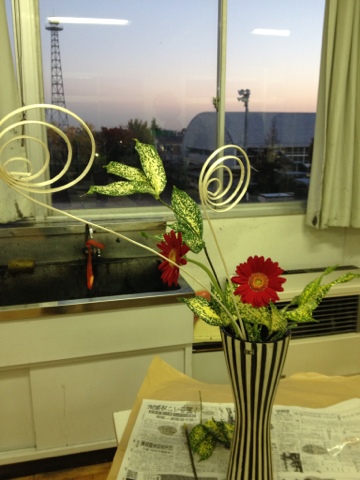Ikebana would usually be defined as the art of Japanese flower arrangement. This idea is nothing new as my prowess (or lack thereof) for the art has been posted in picture form for all to see. I feel as though I should redefine it for myself: ikebana - the art of having your flower arrangement rearranged ever so slightly by the sensei to look a million times better. My new definition aptly describes what happens in Ikebana club even though I'm now a sempai!!
*a sempai is the elder, experienced person in a Japanese organization. The sempai-kouhai relationship is a well respected and time honored tradition everywhere - schools, clubs, jobs, and life in general. The kouhai is the newbie - the inexperienced person who looks up to the sempai as a role model. These relationships are not taken lightly. At graduation, the sempais get gifts from their kouhais and the kouhais honour them with performances and thank you speeches. Also, at drinking parties (nomikais), sometimes the kouhais pay for the sempai and the kouhais make sure the sempai's cup is always full. Very serious indeed.
So this post is actually supposed to be an ikebana update, as I haven't done one in awhile. I'm not actually a sempai in the club, that doesn't happen because I'm a teacher. It's a position that puts me ahead of the sempais... Awkward. Anyway, my esteemed position and status doesn't get me anywhere with ikebana. If only...
First up, a flower arrangement that uses a cross made out of wood to separate the vase into 4 quarters. This occurred sometime in December I think. Note the sunset in the background... At about 4-4:30 pm. Sigh.
2nd: This is our Christmas flower arrangement. It's not ikebana, just flower arranging. The sensei liked the way I used the star garland and wrapped it around. I think she showed the class and probably remarked something about those crazy western esthetics. It took me quite awhile to understand that being different and designing my own arrangement is a no-no. We're supposed to copy the sensei's pretty much exactly. You know the old saying, "the nail that sticks up gets hammered down." Yes, yes, yes. It's exactly true. Though with this particular arrangement we were given more freedom to do as we pleased, hence my peculiar application of the star garland.
3rd: This flower arrangement was in January. It served as a reminder that spring was on its way. Not really though, as I bet I was wearing 2 pairs of pants, and 5 shirts on that day. I'm not sure what kind of blossoms were on the branches. They and the tulips are symbols of spring.
4th: This arrangement was fun because we used the grid again (see #1) and we also manipulated the flowers to our will by bending the stalks, but not breaking them. This arrangement was in honour of setsubun, a topic I was going to blog about but then failed to do so. The pussy willows are supposed to represent beans, which are thrown at the devil on setsubun to cast him out of your home. Setsubun is February 3, is the day before spring starts in Japan. In fact, setsubun means seasonal division. On setsubun, you cast the bad spirits (onni) out of your home and bring the good ones in. Beans are thrown as well as eaten. You must eat your age +1 beans on setsubun for good health and long life. Also on this day, long uncut sushi called ehomaki are eaten, while facing the lucky direction (this year it was SSE I think). The holly in the arrangement is also representative of Setsubun. Traditionally, holly and fish heads were hung at the front doors of houses to keep the onni away. When I went riding about on Setsubun, I was disappointed to discover that no one does this anymore, even though it sounds unpleasant.
5th: This arrangement is a springy one, blossoms and irises. Like #1 and #4 it uses the grid for placement. I had a string of bad luck with my arranging materials, in this one you can see there are only 2 sticks... Not supposed to be the case in ikebana. There should be three, but sadly my branches were terrible and only 2 could be made. Poor, poor flower arrangement.
6th: This arrangement is not traditional ikebana, but it is in honour of a traditional festival. Hinamatsuri (March 3), or Girls' Festival, is a festival where girls are honored and good health, fertility, etc are wished for. Hinamatsuri is marked by large, often expensive displays of dolls meant to be the emperor, empress and their attendants. The tulips in the arrangement are meant to be dolls dressed in kimono. The red tulip is the empress doll and the yellow is the emperor doll. Behind them there are ume blossoms (Japanese plum).
7th: This was the first activity of the new school year. I was pleased to get back to barebones ikebana. This is basic ikebana at its finest - my favourite type because it is so simple, sparse, and somehow esthetically pleasing to me. The basic tenets of this style of ikebana are the branches: the tallest is 2 x the length of the vase, the middle is 1.5 x the length of the vase (or 3/4 the length of the tall branch), and the small branch is 1 x the length if the vase (or half the length of the talk branch). Then the spaces are filled with flowers, in this case, carnations. Quick and easy.
Last: My most recent arrangement. Can you guess what this is supposed to be? More on this arrangement at a later date. Hopefully the suspense won't get to you! He he he.








No comments:
Post a Comment